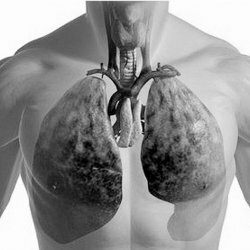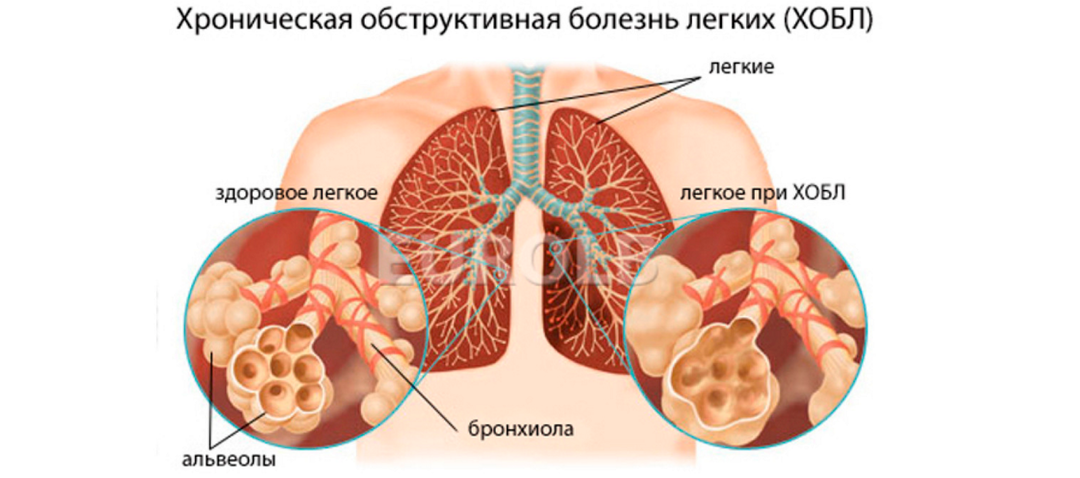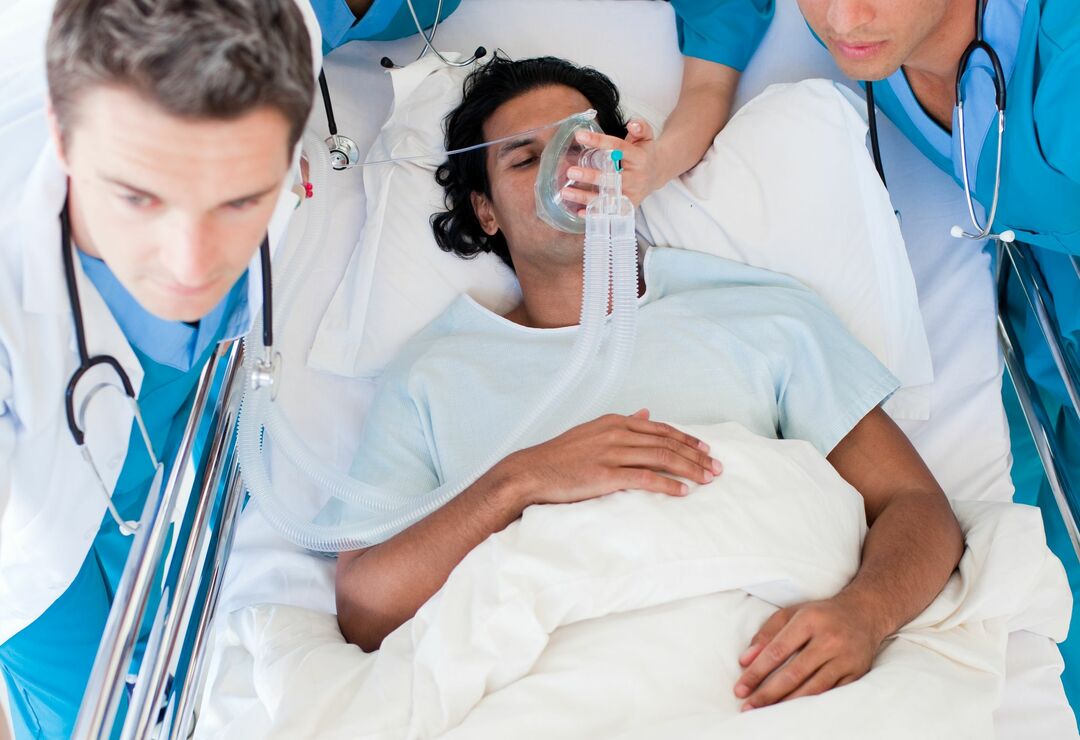Gangrene lungs
 The disease of gangrene of the lung is a process of destruction in the lungs, the characteristics of which are as follows: purulent-putrefactive necrosis of the lung site, which has no clear demarcation, with the possibility of further spread. When the patient is ill, a serious condition is observed. Also there are pains in the area of the chest, high fever, sweating, shortness of breath, pale skin, a sharp decrease in body weight, a large separation of fetid sputum.
The disease of gangrene of the lung is a process of destruction in the lungs, the characteristics of which are as follows: purulent-putrefactive necrosis of the lung site, which has no clear demarcation, with the possibility of further spread. When the patient is ill, a serious condition is observed. Also there are pains in the area of the chest, high fever, sweating, shortness of breath, pale skin, a sharp decrease in body weight, a large separation of fetid sputum.
Diagnosis of the disease consists of radiography, physical examination, bronchoscopy, bacteriological and cytological analysis of sputum. Treatment of the disease is based on infusion therapy, antibiotic therapy, endoscopic sanation of the tracheobronchial tree.
Gangrene lung is the most serious infectious disease. The risk of the disease is associated with the high possibility of many complications, such as pulmonary hemorrhage, pericarditis, sepsis, multiple organ failure. All these complications can lead to the death of the patient.
Causes of the disease
Usually pathogens are microbial associations with anaerobic microflora. Etiological agents that are found in bacterial cultures: golden staphylococci, hemophilic rod, pneumococcus, Pseudomonas aeruginosa and others. The combination of pathogenic properties of associates increases their resistance to antibiotic therapy.
Pathogens fall into the pulmonary tissue by contact aspiration, traumatic, lymphogenous, hematogenous pathways. Sources of pathogenic microflora are the nasopharynx and the oral cavity. The infection of germs in the bronchi is facilitated by caries, gingivitis, periodontitis, pharyngitis, sinusitis and other pathological diseases. The contact mechanism of the disease is associated with local inflammatory processes. For example, pneumonia, lung abscess or others. Lymphogenous and hematogenous infection is less common. Usually they appear after angina, sepsis, mumps, appendicitis, intestinal obstruction and other diseases.
An important role of the pathogenesis of gangrene is the weakening of the body from smoking, alcoholism, and drug addiction. Depleting diseases, taking corticosteroids, impaired immunity, old age, HIV - all these diseases constitute a risk group for gangrene of the lung.
Classification of the disease
By the developmental method:
- is bronchogenic. It is divided into post-pneumonic, aspiration, obturation.
- thromboembolic;
- is post traumatic;
- hematogenous
- is lymphatic.
According to the degree of damage to lung tissue, gangrene is classified as:
- ;
- subtotal;
- total
- double-sided.
Clinical signs of lung gangrene are characterized by respiratory failure, lung tissue damage, inflammation and intoxication, bacterial-toxic shock. The disease always runs hard or very hard.
Symptoms include: high fever, fever, chills, sweat, headache, weight loss, general weakness. There is also a lack of appetite, sleep. There may be a disturbance of consciousness and delirious states. The disease causes pain in the chest, which intensifies with deep inspiration and weakens during quiet breathing. After a couple of days, the patient has a painful cough. It is accompanied by the separation of fetid sputum. Sputum during a cough is separated in large numbers, into a full mouth.
In case of lung gangrene, signs of respiratory failure are strongly pronounced, skin is pale, dyspnea, acrocyanosis. The development of the disease is accompanied by a strong decrease in pressure, tachycardia.
Pneumothorax, empyema of the pleura, pulmonary hemorrhage - complicate the course of the disease and are the causes of death of patients. With a lightning-fast form of the disease, deaths can occur as early as the first day.
Diagnosis of the disease
When examining a patient with gangrene of the lungs, one should pay attention to the patient's serious condition. There is adynamia, cyanosis of fingers and lips, pale shade of skin, sweating, weight loss. The affected half of the chest lags during breathing from the healthy half. Also there is an increased voice trembling. The patient is listening to a variety of wet and dry rales.
Radiography of the lungs. Within the lobe of the lung, extensive darkening is revealed, with the possibility of spreading to neighboring lobes or to the entire lung. During the gangrene lung disease, rapid formation of pleural effusion occurs. It is also clearly visible, with fluoroscopic diagnosis of the lungs or ultrasound examination of the pleural cavity.
When microscopic examination of sputum during the gangrene lung disease, a very large number of erythrocytes, leukocytes, necrotic elements of lung tissue are detected. There is also a lack of elastic fibers. The following bacterial sprouts allow identification of pathogens, making it possible to determine the sensitivity of pathogens to antimicrobial agents. Bronchoscopy shows signs of purulent diffuse endobronchitis. In rare cases, it shows the obstruction of the bronchus with foreign bodies or with tumors.
Peripheral blood analysis shows shifts. This indicates a pronounced inflammatory process. Also in the blood there is anemia, increased ESR, neutrophilic leukocytosis.
Treatment of gangrene lung disease
Treatment of gangrene of the lungs is a very difficult task. Doctors conduct intensive medication, sanation procedures. If necessary, surgical intervention.
The main task with gangrene of the lung is correction of homeostatic disorders and detoxification of the body. For this purpose the doctor prescribes intensive infusion therapy, as well as intravenous injection of plasma-substituting low-molecular solutions, water-electrolyte mixtures, blood plasma, albumin. It is necessary to use vitamins, desensitizing agents, anticoagulants, respiratory analeptics, cardiovascular drugs. The patient is prescribed plasmapheresis, oxygen therapy, inhalation with broncholytics, proteolytic enzymes.
Conservative treatment of the disease is based on antimicrobial therapy. It is based on the combination of two broad-spectrum antibacterial drugs in maximum doses. In rare cases, doctors prescribe a drainage operation.
Prognosis and prophylaxis of gangrene disease of the lung
Although modern medicine successfully treats gangrene of the lungs, but the lethality remains high. More often, the death of patients occurs due to multiple organ failure, pulmonary hemorrhage, pneumogenic sepsis. Timely treatment will hope for a favorable outcome. For the prevention of disease, follow the measures for the sanitary regime, raise the standard of living, eliminate bad habits.



